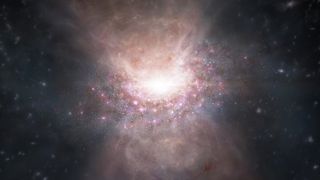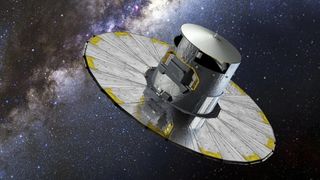quasars
Latest about quasars

Scientists spot 'L-shaped structures' and 'weird things' near monster black hole in epic new Hubble telescope images
By Joanna Thompson published
New Hubble Space Telescope images of a black hole-powered quasar reveal 'weird' structures and gigantic jets of energy that scientists are just beginning to explain.

Scientists make lab-grown black hole jets
By Keith Cooper published
By using protons to probe how a magnetic field responds to an expanding plasma, experimenters have replicated the particle jets spewed out by active black holes.

Astronomers discover the 1st-ever merging galaxy cores at cosmic dawn
By Ben Turner published
Two superluminous quasars, or active black holes at the centers of large galaxies, were found just 900 million years after the Big Bang — the earliest detection of a pair of merging quasars ever seen.

James Webb telescope measures the starlight around the universe's biggest, oldest black holes for 1st time ever
By Ivan Paul published
Astronomers using the James Webb Space Telescope have separated the light of a quasar from the light of its surrounding stars, offering unprecedented insight into how the universe's oldest black holes grew.

'Baby quasars' spotted by James Webb telescope could transform our understanding of monster black holes
By Jennifer Nalewicki published
Scientists think that by studying a cluster of "baby quasars," they can get a better understanding of supermassive black holes in the early universe.

Astronomers spot gigantic black hole killing a galaxy's star formation at the dawn of time
By Ben Turner published
Observations made by Chile's ALMA telescope have revealed a gigantic quasar quenching a galaxy's star formation — a first-of-its-kind observation in the early universe.

Universe's oldest X-ray-spitting quasar could reveal how the biggest black holes were born
By Robert Lea published
The newly identified quasar, observed 13.7 billion light-years away by the James Webb Space Telescope and Chandra X-ray Observatory, could be an example of a heavy black hole "seed" in the early universe.

Gaia spacecraft reveals 'goldmine' of over 500,000 undiscovered stars
By Robert Lea published
The European Space Agency's Gaia telescope revealed half a million newfound stars, and detailed the orbits of over 150,000 asteroids.
Sign up for the Live Science daily newsletter now
Get the world’s most fascinating discoveries delivered straight to your inbox.


